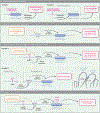The Key Role of Epigenetics in Human Disease Prevention and Mitigation
- PMID: 29617578
- PMCID: PMC11567374
- DOI: 10.1056/NEJMra1402513
The Key Role of Epigenetics in Human Disease Prevention and Mitigation
Figures


Comment in
-
The Key Role of Epigenetics in Human Disease.N Engl J Med. 2018 Jul 26;379(4):400. doi: 10.1056/NEJMc1805989. N Engl J Med. 2018. PMID: 30048067 No abstract available.
-
The Key Role of Epigenetics in Human Disease.N Engl J Med. 2018 Jul 26;379(4):400. doi: 10.1056/NEJMc1805989. N Engl J Med. 2018. PMID: 30048068 No abstract available.
References
-
- Waddington CH. The strategy of the genes: a discussion of some aspects of theoretical biology. London: Allen & Unwin, 1957.
-
- Thirlwell C, Eymard M, Feber A, et al. Genome-wide DNA methylation analysis of archival formalin-fixed paraffin-embedded tissue using the Illumina Infinium Human-Methylation27 BeadChip. Methods 2010; 52:248–54. - PubMed
Publication types
MeSH terms
Substances
Grants and funding
LinkOut - more resources
Full Text Sources
Other Literature Sources
Medical
